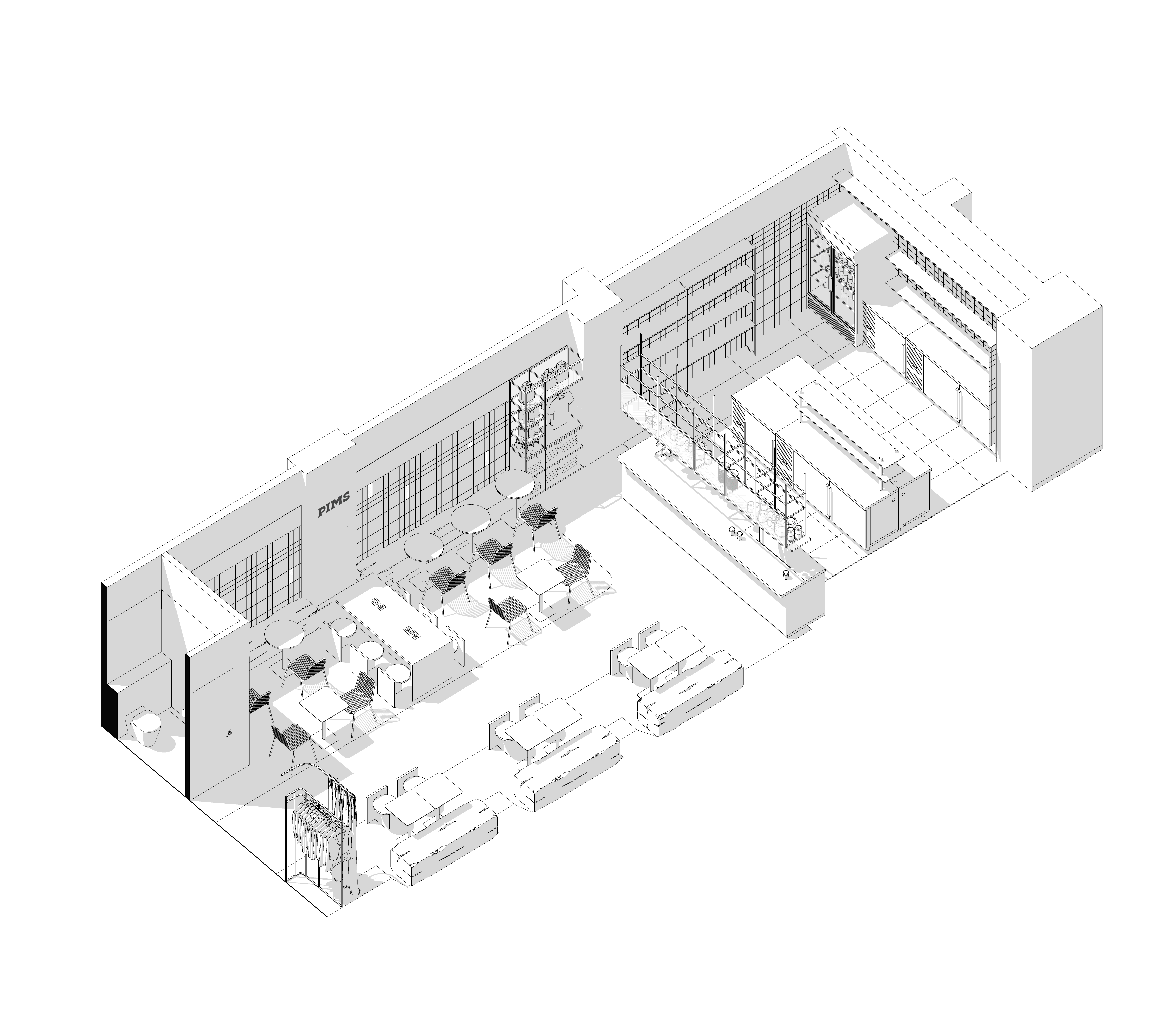对于第一个旗舰店PIMS TEA,我们把概念建立在自然和人造材料的对比上。聚碳酸酯、金属、霓虹灯和玻璃等合成材料的表面与原木长椅、石头纹理的墙壁以及从红色花岗岩碎石中伸出的干花相结合。强烈的标志性色彩、反光和半透明的材料被编织在粗糙的表面和物体中。在一个相对较小的区域内,我们设法容纳了32个舒适的座位,一个完整的厨房和一个带有等待区的现金台,窗帘后面的衣柜,以及一个放置商品的架子。
For the first flagship PIMS TEA, we built the concept on the contrast of natural and man-made materials. Synthetic surfaces such as polycarbonate, metal, neon, and glass are combined with log benches, stone-textured walls, and dried flowers sprouting from the floor through red granite rubble. Intense signature colors, reflective and translucent materials are woven into rough surfaces and objects. In a relatively small area, we managed to accommodate 32 comfortable seats, a full kitchen and a cash desk with a waiting area, a wardrobe behind the curtain, and a shelf for merch.
降落区的中心元素是一张由人造蓝石制成的公共桌子–它的纹理与地面的水磨石相呼应。所有的座位都配备了插座,使PIMS成为使用笔记本电脑工作的好地方。蓝色丙烯酸和霓虹灯的外部标志与历史悠久的外墙形成鲜明对比,吸引了路人的注意。
The central element of the landing zone is a communal table made of artificial blue stone – its texture echoes the terrazzo from which the floor is made. All seats are equipped with sockets, making PIMS a great place to work with a laptop. The exterior sign in blue acrylic and neon contrasts with the historic façade, drawing the attention of passers-by.
由于主要是浅色的装修,所以可以保持通风的感觉–大窗户、白色瓷砖和石膏墙、浅色家具–一切都可以作为蓝色点缀、干花和小细节的中性背景。在温暖的季节,带内置不锈钢桌的原木长椅被放置在外面的窗户上。这个空间最主要的,但第一眼看不出来的语义重点是一块透明的瓷砖,里面冻结着鲜花和草药–像茶一样,用芳香的花瓣和叶子装饰。
Due to the predominantly light finish, it was possible to preserve the feeling of airiness – large windows, walls in white tiles and plaster, light furniture – everything works as a neutral background for blue accents, dried flowers, and small details. For the warm season, log benches with built-in stainless steel tables are placed into the windows from the outside. The main, but not noticeable at first glance, the semantic accent of the space is a transparent tile with flowers and herbs frozen in it – like tea, decorated with fragrant petals and leaves.

通过在茶馆的墙壁上嵌入茶的符号,我们从物理上和视觉上反映了它与PIMS的不可分割性。这个项目中最小的元素花费了最多的时间来阐述和实施–从寻找承包商到商定瓷砖的最终外观。环氧树脂带来了有趣的3D效果,这在照片上很难表达,但在现场观看时却完全不可能与印刷品混淆。
By embedding the symbol of tea in the walls of the teahouse, we physically and visually reflect its inalienability from PIMS. The smallest element in the project took the most time to elaborate and implement – from finding contractors to agreeing on the final look of the tile. Epoxy resin gives an interesting 3D effect, which is difficult to convey in a photograph, but completely impossible to confuse with a printed image when viewed live.
Architects: KIDZ
Area: 72 m²
Year: 2020
Photographs: Polina Poludkina
Manufacturers: Delo design, EQUIPE CERAMICS
Lead Architects: Egor Bogomolov, Ivan Gorbunov, Victor Aurov, Daria Papkova
Custom Furniture:A3 Furniture
City:Moscow
Country:Russia




















